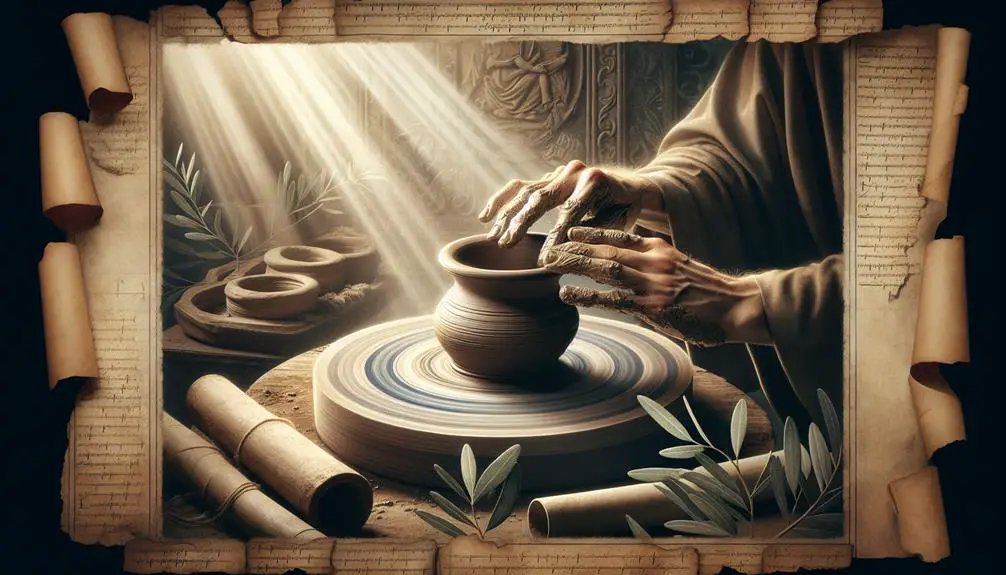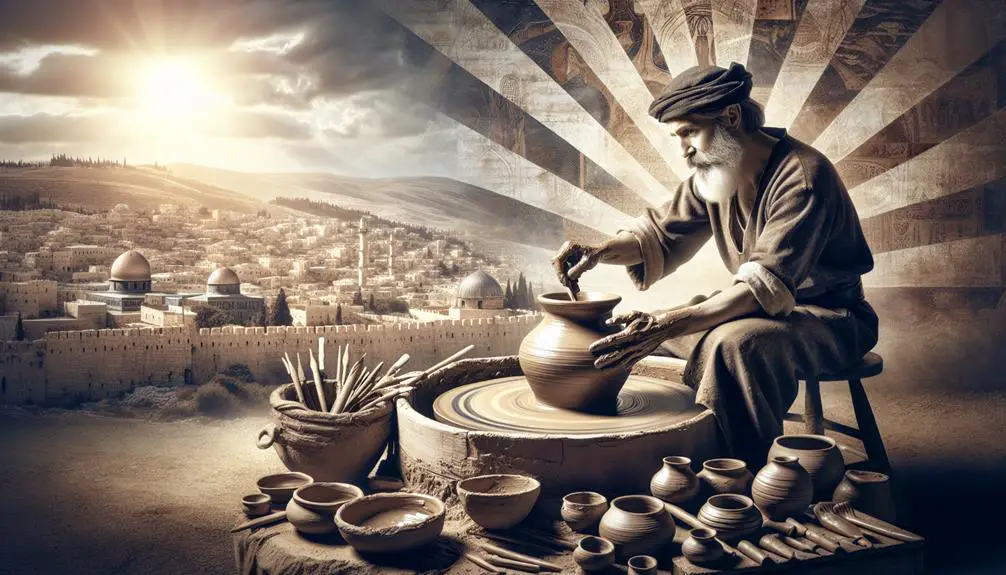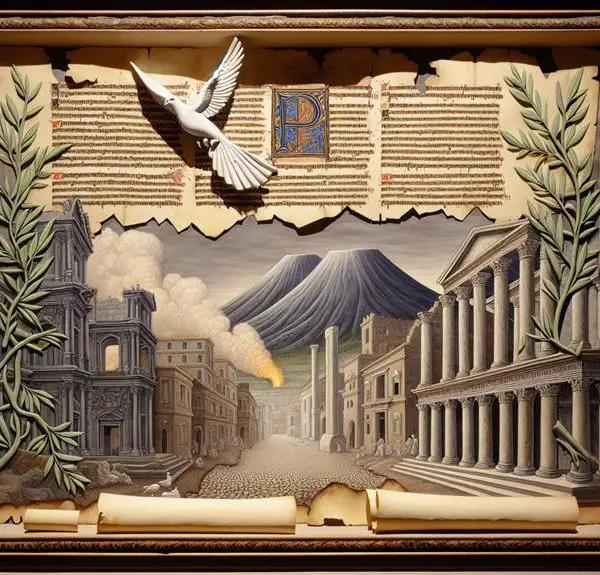Witness the profound journey of divine creation and human purpose through the timeless metaphor of the potter and clay in the Bible.

Potter Verses in the Bible
The metaphor of the potter and the clay, as depicted in various verses of the Bible, offers a profound exploration of divine sovereignty and human agency.
From its origins in the book of Jeremiah to its nuanced echoes in Isaiah, and further reflections in the New Testament texts of Romans and Second Corinthians, this imagery serves as a central motif for understanding the dynamic relationship between the Creator and creation.
As we embark on a journey to unravel the layers of meaning behind these potter verses, we invite readers to consider the implications of this metaphor for personal transformation and its relevance in contemporary spiritual discourse.
Key Takeaways
- Potter verses symbolize divine sovereignty and human malleability, illustrating God's control and reshaping authority.
- These verses highlight the dynamics between divine craftsmanship and human receptivity, emphasizing personal transformation.
- They reflect on the balance of divine sovereignty and human responsibility, underscoring the role of free will and grace.
- Potter imagery in the Bible encompasses themes of creation, transformation, and renewal, pointing to spiritual growth and the promise of a new creation.
The Metaphor Explained

The metaphor of the potter, as presented in the Bible, serves as a profound allegory for divine sovereignty and the human condition, inviting a nuanced exploration of its theological and existential implications. This imagery, rich in cultural symbolism, encapsulates themes of creation, authority, and transformation, resonating across various contexts and epochs. The potter's act of molding clay into a desired form eloquently symbolizes the omnipotence of the divine creator, shaping the destinies of individuals and nations according to divine will.
Artistic interpretations of this metaphor have varied widely, reflecting the diverse cultures and artistic movements through which the biblical narrative has been transmitted. In visual arts, the potter and clay motif has been depicted in ways that emphasize the meticulous care and intentionality of the creator, thereby highlighting themes of divine benevolence and meticulous design. In literature, this metaphor has been explored to probe the depths of the human psyche, often focusing on the existential struggle inherent in the human experience of being shaped by forces beyond one's control.
The potency of the potter metaphor extends beyond its immediate religious context, tapping into universal themes of identity, agency, and purpose. It invites a reflection on the nature of human will in the face of divine omnipotence, offering a rich tapestry of interpretation that bridges doctrinal divides. The interplay between cultural symbolism and artistic interpretations of this metaphor underscores its enduring relevance, serving as a testament to the multifaceted nature of biblical allegory and its capacity to engage with the fundamental questions of human existence.
Origins in Jeremiah

Exploring the origins of the potter metaphor, one finds its seminal expression in the book of Jeremiah, where it serves as a pivotal illustration of divine authority and human malleability. In this biblical narrative, the metaphor is richly layered with clay symbolism, offering profound insights into the nature of the relationship between the creator and the created. The historical context of Jeremiah's prophecies adds depth to our understanding of this imagery, accentuating its significance in the ancient world.
The use of the potter metaphor in Jeremiah effectively encapsulates several key themes:
- Divine Sovereignty: Emphasizes God's absolute power to shape and reshape nations according to divine will, just as a potter molds clay.
- Human Accountability: Suggests that, like clay in the potter's hands, individuals and communities are responsible for their actions, with their fate contingent upon their responsiveness to divine guidance.
- Repentance and Transformation: Offers hope for renewal and change, proposing that, through repentance, a flawed vessel can be remade into something new and beautiful.
- Vulnerability of Creation: Highlights the fragility of human constructs and the ease with which they can be undone, underlining the need for humility and obedience.
- Historical Context: Situates the metaphor within the tumultuous period of Jeremiah's life, reflecting the political and social upheavals of his time, and the role of prophecy in guiding the people.
Echoes in Isaiah

Several instances in the book of Isaiah reflect the enduring influence of the potter metaphor, revealing its thematic resonance across different contexts and periods. This metaphor, rich in ceramic symbolism, underscores the sovereignty of God over nations and individuals, akin to a potter's control over clay. This imagery not only highlights the creative power but also the authority to reshape, suggesting a dynamic relationship between the creator and the creation. The prophetic imagery in Isaiah, therefore, serves as a profound exploration of divine intention and human agency.
Isaiah's use of the potter metaphor extends beyond a mere literary device; it encompasses a theological assertion about divine prerogative and judgment. In this prophetic context, the metaphor is not static; it evolves to address the circumstances of the time, reflecting concerns of justice, mercy, and repentance. The clay, symbolizing the people, becomes a canvas for depicting the consequences of obedience and disobedience to God's will. Thus, the ceramic symbolism in Isaiah is multi-layered, speaking to both imminent historical realities and overarching spiritual truths.
Analyzing the echoes of the potter metaphor in Isaiah, scholars observe a nuanced interplay between judgment and hope. The imagery serves as a reminder of God's omnipotence and the possibility of transformation—a cornerstone of prophetic literature. This duality underscores the complexity of the relationship between God and humanity, marked by both vulnerability and the potential for renewal.
Reflections in Romans

Building upon the foundational themes presented in Isaiah, the New Testament book of Romans further elaborates on the potter metaphor, offering a nuanced understanding of divine sovereignty and human responsibility. In Romans, the Apostle Paul engages deeply with the idea of God as the potter, crafting his argument around the dynamics of grace and the comparison between the Law and faith. This exploration presents a multifaceted view of salvation history and the believer's place within it.
Key points to consider from Romans include:
- Divine Sovereignty vs. Human Will: Romans addresses the tension between God's sovereign choice and human free will, illustrating how both operate within the framework of salvation.
- Role of Grace: The book emphasizes the dynamics of grace, presenting it as the unmerited favor that supersedes the Law's demands.
- Law Comparison: Paul offers a critical Law comparison, arguing that the Law identifies sin but cannot save, a role fulfilled by grace through faith.
- Transformational Power of the Spirit: Romans highlights the transformative work of the Holy Spirit, who reshapes believers into the image of Christ, akin to the potter molding clay.
- Ethical Implications: The metaphor extends to ethical living, suggesting that being molded by God results in a life that reflects His righteousness, beyond mere adherence to the Law.
Through these reflections in Romans, the potter metaphor becomes a rich canvas for exploring the complexities of faith, grace, and obedience. The book invites believers to see themselves as clay in the potter's hands, being shaped according to His purpose and mercy.
Insights From Second Corinthians

Delving into Second Corinthians reveals a continuation and deepening of the themes of divine craftsmanship and human receptivity, as Paul further articulates the role of suffering, comfort, and reconciliation in the believer's life. This epistle stands out as a poignant reflection on the nature of apostolic ministry, undergirded by Paul's defense of his authority and an exposition on the dynamics of spiritual warfare.
Paul's authority, questioned by some in Corinth, becomes a central theme as he asserts his apostolic legitimacy, not through worldly measures of success or rhetorical skill, but through the evidence of suffering for Christ's sake. This perspective is critical, as it shifts the focus from human accolades to divine approval, underscoring the paradox that strength is found in weakness and victory in surrender. Paul's discourse on his trials and God's sustaining grace serves as a testament to the power of God's craftsmanship in transforming suffering into a means for comfort and reconciliation.
Moreover, Second Corinthians delves into the concept of spiritual warfare, elucidating the believer's engagement in battles not against flesh and blood, but against spiritual forces. Paul emphasizes the necessity of divine armor, highlighting the weapons of righteousness, truth, and the proclamation of the Gospel. This spiritual arsenal is foundational for overcoming the adversities faced by believers, pointing to the ultimate victory in Christ.
Personal Transformation Themes

Exploring the theme of personal transformation in Second Corinthians further illuminates how Paul's teachings on suffering and spiritual warfare are intricately linked to the believer's journey towards spiritual maturity and renewal. This theme resonates deeply with the concept of character evolution witnessed in various magical narratives, where protagonists often undergo significant transformations to fulfill their destinies.
Paul's epistles emphasize the transformative power of faith and hardship, paralleling the character evolution seen in magical narratives. This comparison encourages readers to view their spiritual journey as a dynamic process of change and growth, akin to the quests undertaken by heroes in these stories.
Key aspects of personal transformation themes in Second Corinthians include:
- The refining power of suffering: Just as characters in magical narratives often face trials that catalyze their growth, Paul suggests that suffering refines believers, molding them into more spiritually mature individuals.
- The role of spiritual warfare: The believer's struggle against spiritual forces is likened to the epic battles seen in magical narratives, emphasizing the importance of perseverance and faith for personal transformation.
- Renewal through faith: Faith acts as a catalyst for personal renewal, mirroring the way belief in oneself or a greater cause propels characters in magical tales towards their evolution.
- The promise of a new creation: Paul's vision of believers as new creations echoes the transformative journeys of protagonists in magical stories, where characters often emerge radically changed.
- The communal aspect of transformation: Just as characters in magical narratives frequently rely on a community for support and growth, Paul highlights the importance of the Christian community in the believer's transformation process.
Applying Potter Imagery Today

In contemporary contexts, Potter imagery serves as a potent tool for illustrating complex themes of resilience, community, and moral choices, drawing parallels with timeless human struggles and aspirations. The metaphor of the potter and clay, rooted in biblical narratives, finds renewed relevance in today's world, where the act of crafting ceramics echoes the shaping of individual and collective identities. This imagery encapsulates the dynamic process of formation and transformation, resonating deeply with contemporary quests for meaning and authenticity.
Modern adaptations of Potter imagery extend beyond the literal creation of ceramics, embodying the broader principles of creativity, adaptability, and the human capacity for change. Through this lens, the potter's wheel becomes a symbol of life's cyclical nature, with each turn representing the trials and triumphs that shape human character. The meticulous process of molding, firing, and glazing parallels the experiences that forge individual resilience and communal bonds, highlighting the interplay between external influences and inner strength.
Analyzing the application of Potter imagery today reveals its enduring power to communicate profound truths about the human condition. By invoking the tactile, elemental act of shaping clay, this metaphor bridges historical and cultural divides, offering a universal language for exploring the depths of human experience. It underscores the significance of intentionality, patience, and perseverance in the journey toward self-discovery and collective well-being, thereby affirming the timeless relevance of these ancient narratives in illuminating the path of modern life.
Frequently Asked Questions
Are There Genuine Parallels Between the Harry Potter Series and the Bible, or Are These Connections Merely Coincidental or Forced Interpretations?
The inquiry into the existence of genuine parallels between a popular literary series and ancient religious texts necessitates a nuanced examination.
This involves exploring themes of magic and morality, alongside allegorical interpretations, to discern if similarities are substantive or the result of coincidental or contrived analyses.
Scholarly, objective evaluation is crucial in determining whether these connections are inherent and meaningful, or if they arise from external imposition of meaning onto the texts.
How Do Religious Scholars and Theologians View the Comparison Between Harry Potter Verses and Biblical Scriptures?
Religious scholars and theologians approach the comparison of literary texts with scripture through a lens of magical ethics and literary analysis. They dissect narratives, seeking wisdom hidden within allegorical tales.
In their scholarly examination, they maintain an objective stance, analyzing the moral and ethical parallels without defaulting to subjective interpretations. This analytical methodology allows them to explore the depths of both canonical religious texts and contemporary literature, including discussions that juxtapose fictional narratives with biblical scriptures.
Has J.K. Rowling Ever Commented on or Acknowledged Any Biblical Influences in Her Writing of the Harry Potter Series?
J.K. Rowling has publicly acknowledged various inspirations behind her Harry Potter series, blending a rich tapestry of mythological, literary, and cultural references.
Literary analysis reveals that Rowling, while not explicitly citing biblical influences, has incorporated themes of sacrifice, redemption, and the battle between good and evil, resonating with universal motifs found in religious texts.
Rowling's inspirations are eclectic, suggesting a synthesis of her broad literary and philosophical interests rather than direct biblical allusions.
How Do Fans of the Harry Potter Series, Particularly Those From Religious Backgrounds, Reconcile Their Love for the Series With Their Faith?
How do individuals navigate the captivating world of Harry Potter without compromising their moral compass?
Fan communities, particularly those from religious backgrounds, often engage in thoughtful discourse on magical ethics, exploring the series' underlying messages of love, sacrifice, and the distinction between good and evil.
Through analytical and scholarly discussions, they reconcile their enjoyment of the series with their faith, finding parallels that affirm rather than contradict their beliefs.
What Has Been the Reaction of Various Religious Groups to the Notion of Drawing Parallels Between the Bible and the Harry Potter Series?
The reaction of various religious groups to the concept of aligning the Harry Potter series with biblical narratives has been multifaceted, sparking censorship debates and influencing marketing strategies.
While some sects view the parallel as enriching, offering a modern avenue for discussing moral and ethical issues, others perceive it as blasphemous, leading to calls for the books' removal from educational contexts.
This dichotomy underscores the complex interplay between contemporary literature and traditional religious beliefs.
Conclusion
In conclusion, the potter imagery found within the Bible serves as a profound metaphor for God's sovereignty and the transformative process of spiritual formation. Through the examination of passages from Jeremiah, Isaiah, Romans, and Second Corinthians, one discerns the rich tapestry of meaning that surrounds this metaphor.
What does this imagery teach us about our relationship with the divine? It underscores the dynamic process of being shaped and reformed by the omnipotent hands of God, highlighting themes of submission, transformation, and ultimate purpose.
This metaphor remains as relevant today as it was in ancient times, offering profound insights into the nature of divine interaction and personal growth.



Sign up